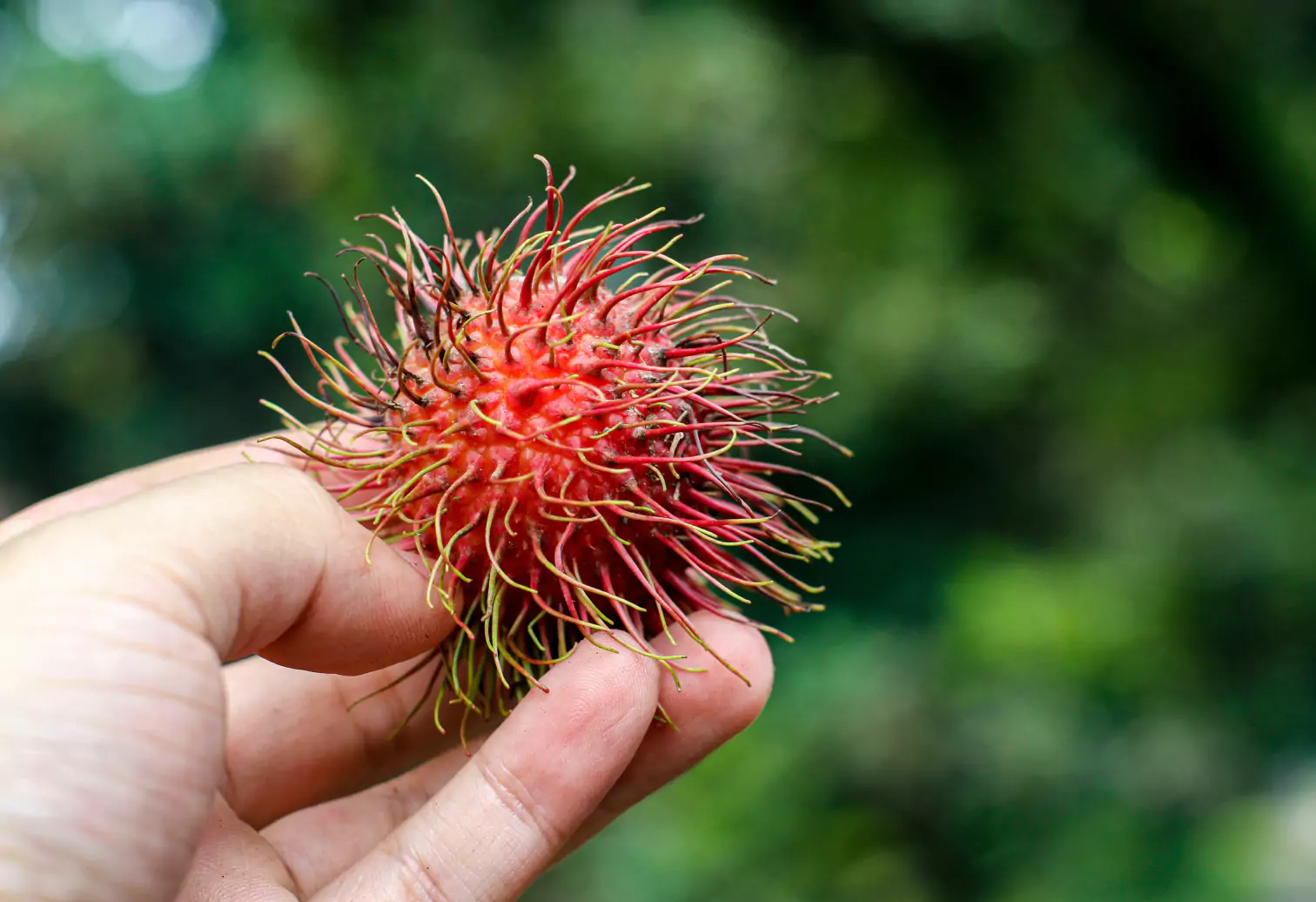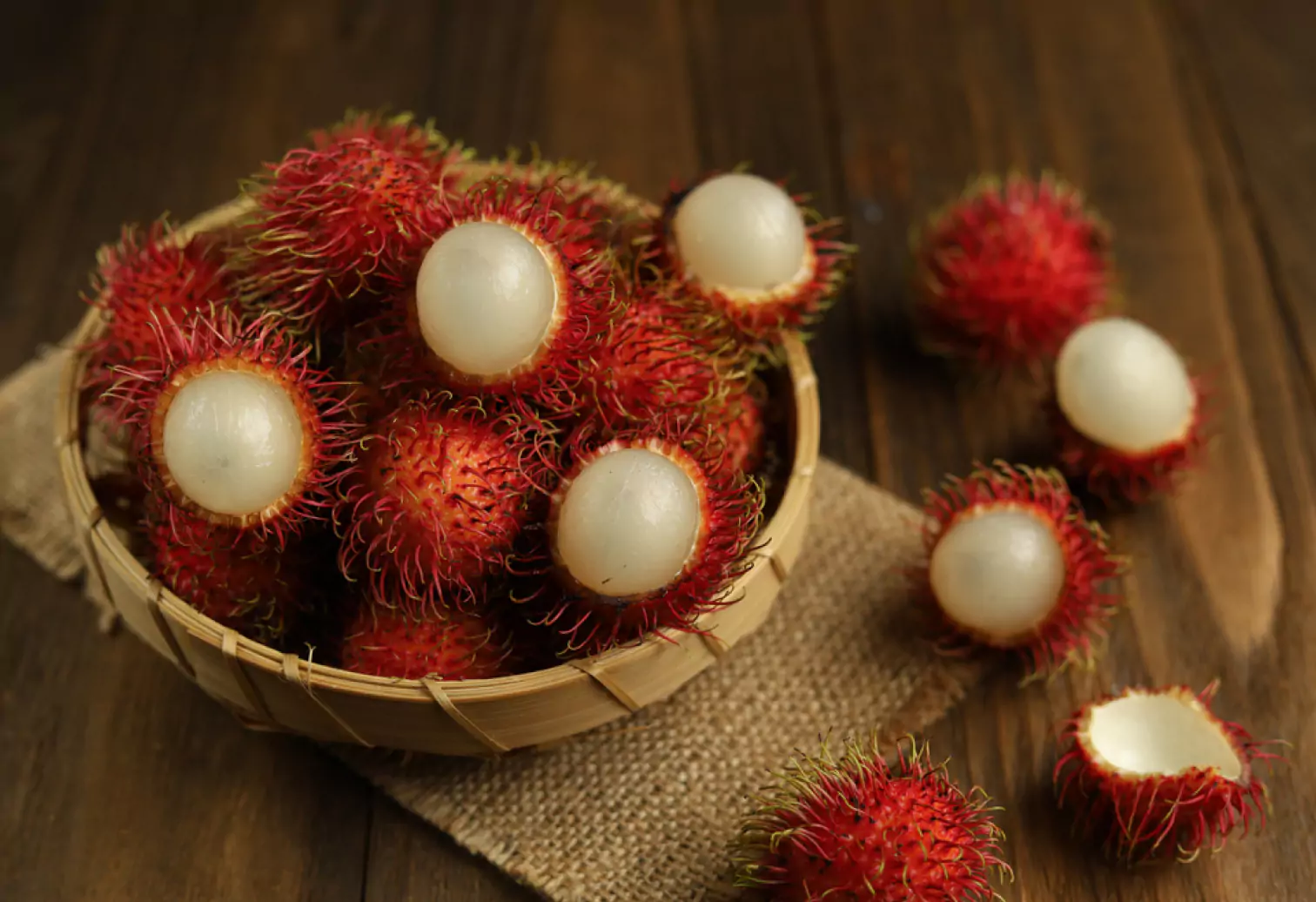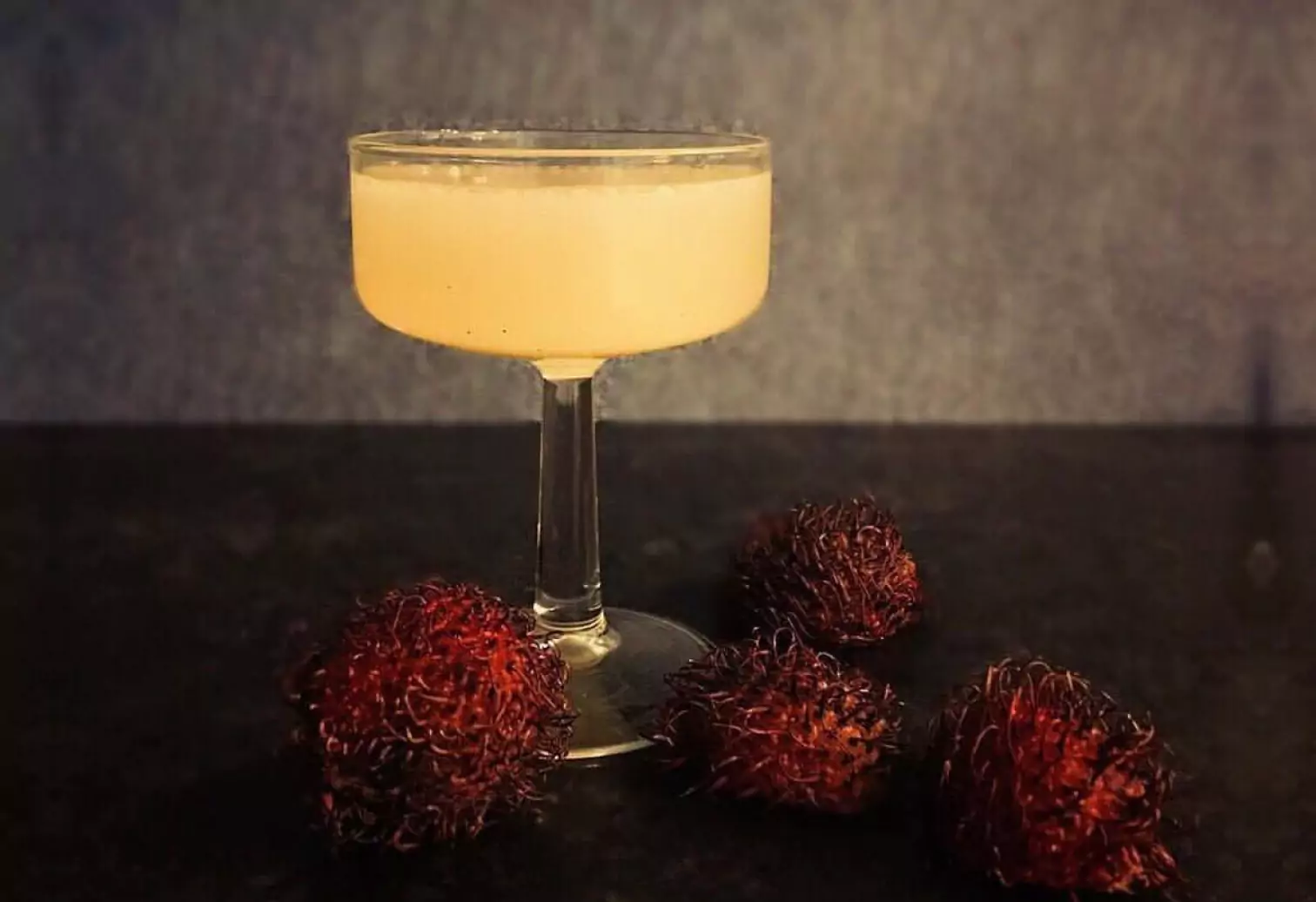Rambutan Benefits: Exploring the Advantages of this Fruit

Key Takeways
You may not have heard of the rambutan before, but this unusual fruit is actually quite popular in many parts of the world. It’s a tropical fruit that grows on the Rambutan tree in Southeast Asia.
If you have heard of it, you already know how delicious it is! The name comes from the Malay word for "hairy," which is apt as the fruit has a thin layer of soft fuzz covering it. But what really is a rambutan, and where can you find one?
What is a Rambutan

The rambutan is from the same family (the soapberry or Sapindaceae family) as other delicious fruits like the lychee fruit and longan fruit. Inside the furry red or green skin is white flesh and a large seed.
The red-haired fruits are slightly acidic, with a texture that’s almost like jelly—they’re similar to lychees in that they boast a similar sweetness and juiciness.
The tree that produces rambutan fruit is native to Thailand, Malaysia, Indonesia, and the Philippines, but the fruit is now grown in regions with tropical climates worldwide, including Hawaii and Central America. So while you may not find them in your local supermarket, they’re not as difficult to source as they once were. Rambutans can be eaten fresh or used in jams, jellies, and other preserves.
They are also a popular ingredient in Asian desserts and are in sorbets, ice creams, and fruit salads. In addition to their culinary uses, rambutans are also known for their medicinal properties. Read on to find out more about the health benefits of rambutans and how to eat them, then scroll down for our favorite recipes to try using the fresh fruit.
The Health Benefits of Eating Rambutan

Rambutans (their taxonomic name is Nephelium lappaceum) are a tropical fruit with a bright red, hairy outer shell. As we’ve learned, rambutans may be native to Southeast Asia, but they’re increasingly popular worldwide.
They’re pretty delicious, but that’s not the only reason to consider eating them. Traditionally used in Chinese medicine, the fruit contains antioxidants like vitamin C that help to protect against cell damage and disease. Today, rambutans are gaining popularity as a health food due to their varied potential health benefits.
Rambutans are an excellent source of potassium, calcium, and dietary fiber. So it’s not surprising they contain many health benefits, including boosting immunity, promoting healthy skin, and aiding digestion. Here’s a little more about the fruit and its health benefits:
- The fruit contains vitamin C, essential for a strong immune system.
- Rambutans are also low in calories and fat, making them a good choice for people watching their weight.
- In addition to their nutritional value, rambutans are also believed to have anti-inflammatory properties. It makes them beneficial for people suffering from conditions like arthritis or gout.
- One study found that rambutans can help to reduce inflammation in the gut because soluble fiber helps the “good” bacteria in your gut create short-chain fatty acids.
Read on for a breakdown of a few of these benefits.
Rambutans and Antioxidants
Rambutans are an excellent source of antioxidants, compounds that help protect cells from damage. Antioxidants have numerous health benefits, including reducing your risk of cancer and heart disease.
They’re molecules that can safely interact with and neutralize free radicals. Free radicals are damaging by-products of metabolism, environmental exposure, and inflammation. Antioxidants donate an electron to the free radical to neutralize them, stopping the reaction and preventing cellular damage.
You’ll typically find these compounds in many foods, including fruits, vegetables, whole grains, and nuts. They are also in dietary supplements. Vitamins C and E are two of the most well-known antioxidants, but many others, including beta-carotene, lycopene, and flavonoids.
Rambutans and Blood Glucose
One of the best things about rambutans is that they are blood-glucose friendly. In fact, studies have shown that eating rambutans can help to lower blood sugar levels and improve glucose tolerance.
If you have diabetes or are at risk of developing it, incorporating rambutans into your diet can be a great addition to your glucose management plan.
Rambutans are an excellent source of dietary fiber, and they also contain a type of sugar called fructose, which your body absorbs slowly. Remember, even though it may have a slightly lower impact on glucose levels in your blood, it has to be converted into glucose by your liver before your body can use it for energy.
So, it’s best to consume this in moderation as high-fructose intake can affect your liver and may have other adverse health consequences, including insulin resistance.
The fiber content in rambutans also helps to slow down the digestion of other sugars, further preventing spikes in blood sugar levels.
Rambutans and Weight Loss
Rambutans are a delicious tropical fruit that can complement a weight loss journey. Rambutans are lower in calories and sugar than lychees, making them excellent for those looking to lose weight.
Because rambutans are also rich in fiber, which helps to keep you feeling full and satisfied after eating. Additionally, vitamin C aids in the absorption of fat.
And, because they're packed with water, rambutans can help keep you hydrated and prevent overeating. While more research is needed, rambutans may offer some benefits for those looking to lose weight.
Rambutans and Digestion
In addition to being delicious, rambutans can also be good for your digestive health. The fruit's flesh is rich in soluble fiber, which helps keep the digestive system running smoothly.
They contain a type of soluble dietary fiber known as pectin, which can help lower cholesterol levels and slow the absorption of sugar in the intestines.
As a result, eating rambutans may help to improve digestive health.
How to Prepare Rambutans

Start by washing the rambutans and cutting off the spiky outer shell. Inside, you'll find a smooth, white fruit with a pit in the center. To eat the flesh inside, peel and discard the skin and eat around or pull it off the pit. Rambutans are best enjoyed as fresh fruit, but they can also be canned or dried.
Add them to yogurt or steel-cut oats for a nutritious breakfast, or enjoy them as a healthy snack. When choosing rambutans at the grocery store, look for fruits that are bright in color and free of bruises or blemishes.
The skin should be tight, and the fruit should give slightly when squeezed. Ripe rambutans will keep for several days at room temperature, or you can put them in the fridge to extend their shelf life.
Fun Rambutan Recipes
The best thing about the rambutan is that you can add it to a range of recipes. The fruit is surprisingly versatile and good in savory and sweet dishes alike. It also makes a great cocktail!
Savory Rambutan

Did you know you could use rambutan in curry? The fruit lends itself well to a spicy and sweet dish. Try our favorite Summer Rambutan Curry from Saveur.
You’ll Need
- 1 teaspoon ground turmeric
- 4 garlic cloves, roughly chopped
- 4 kaffir lime leaves, torn
- 3 red Thai chiles, stemmed
- 1 stalk lemongrass, smashed, fibrous outer layers removed, and inner core thinly sliced
- One 2-inch piece galangal root, peeled and thinly sliced
- 8 rambutan
- 2 tablespoons peanut oil
- 1⁄2 small pineapple, peeled, cored, and cut into 1-inch cubes
- 1 medium yellow onion, thinly sliced
- 2 1⁄2 cups coconut milk
- 2 cups chicken stock
- 1 pound boneless skinless chicken breasts, thinly sliced on a bias
- 1 tablespoon. fish sauce
- 2 teaspoon palm sugar or light brown sugar
- Cilantro leaves, for garnish
- Lime wedges, to serve
- Cooked white rice to serve
Sweet Rambutan
An easy way to incorporate this tropical fruit into your diet is with a fruit salad. You can add whatever you like, but here’s a quick Fruit Salad from Eat Me that we love.
Our Nutrition Team recommends starting with a smaller portion size. Since it's all fruit, it could lead to a glucose spike for some so it’s best to pair this delicious salad with a protein source.
You’ll Need
- 12 rambutans
- 1 mango
- 1 mini pineapple
- 1 pomegranate
- 125 grams blueberries
Fun With Rambutans

We’re big fans of fruit cocktails, and this one, in particular, is a great option with summer just around the corner. Try these delicious Rambutan Martinis from Cooking on the Weekends
You'll Need
- ¼ cup sugar (Pro Tip: Our Nutrition Team suggests replacing this with stevia for a lower glycemic option)
- ¼ cup water
- 8 fresh rambutans
- 4 to 5 ounces vodka
- 2 teaspoons lime juice
- ½ teaspoon vanilla
- 1 cup ice
Find the right Nutrisense programto turn insight into progress.
Go Beyond Glucose Data with Nutrisense
Your glucose can significantly impact how your body feels and functions. That’s why stable levels are an important factor in supporting overall wellbeing. But viewing glucose isn't enough. Nutrisense, you’ll be able to learn how to use your body's data to make informed lifestyle choices that support healthy living.
One-to-one coaching
Sign up to access insurance-covered video calls to work with a glucose expert: a personal registered dietitian or certified nutritionist who will help tailor your lifestyle and diet to your goals.
Monitor and measure what matters
With the Nutrisense CGM Program, you can monitor your glucose with health tech like glucose biosensors and continuous glucose monitor (CGM)s, and analyze the trends over time with the Nutrisense App. This will help you make the most informed choices about the foods you consume and their impact on your health.
Find your best fit
Ready to take the first step? Start with our quiz to find the right Nutrisense program to help you take control.

Amanda is a Nutrition Manager and Registered Dietitian, with a Masters in Dietetics from Stephen F. Austin State University. Originally from south GA, she got her undergrad degree from Texas Tech University. She worked at a hospital in Fort Worth, TX, for 4 years as a dietitian, counseling those living with HIV.




